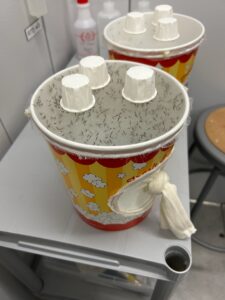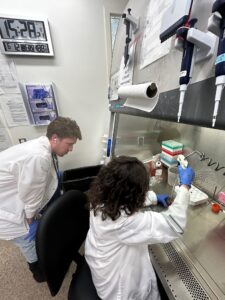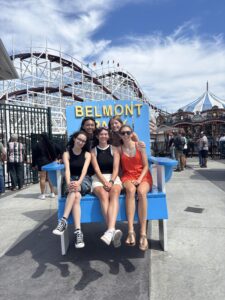Hello everyone!! I’m Azari and I’m interning at the Burton Lab at Scripps Research in San Diego this summer. I work with Nathan Beutler, a post-doctorate immunologist who, through antibody discovery and therapeutic design, is working to understand why an effective vaccine for malaria hasn’t been developed yet. The lab itself isolates and characterizes antibodies that are crucial for fighting viruses such as HIV, malaria, SARS-CoV2, Lassa virus, etc. The immunology and microbiology department at Scripps plays a vital role in the ongoing development of various vaccines. My first week was very content heavy but I enjoyed every second of it. I’ve only been working with one of two of my mentors (Nate B.) since the other (Benjamin Nemoz) is in France for work. I’ve been working alongside Shiloh, another Pintern, and her mentor Nathan Liendo. At first Shiloh and I thought we shared a mentor named Nathan, but they’re two different people who happen to share a name and work at the same place.
The first day Shiloh and I spent half an hour looking for our lab and once we got there Terrence, the lab manager, showed us around and got us situated. Most of our day was spent doing safety trainings so we could begin working. The next day we started doing the actual hands-on work. We began with pipette training. The lab uses microliters (one-millionth of a liter) in their work because the measurements they make are tiny and have to be perfect. We did pretty well, I was statistically better than Shiloh by a hundredth of a percent (brag). Both Nates also gave us a quick presentation on their individual work and what we would be doing with each of them. The next day Nate B. took us to UCSD to show us the process of getting the malaria parasite from mosquitoes’ salivary glands. We were introduced to Jordan, one of the people who meticulously extracts the salivary glands/malaria out of infected mosquitoes. We observed the parasite later that day. Nate B. took us to another building at UCSD where the animals they test on are kept. The mosquitoes are grown there, they feed on transgenic mice infected with malaria, they contract malaria, and are ready to be dissected. The pre-malaria mosquitoes are kept in popcorn buckets (cheap and easy to dispose of) in humid and warm conditions to maintain their health. The infected mosquitoes are kept in 37°C “fridges” to keep the parasite alive until dissection.
He had to run to a meeting, so I joined Shiloh in shadowing Nate L. beginning the process of creating antibody proteins from DNA, also known as the central dogma (DNA->RNA->protein). The first step is incubating DNA/plasmids (ring of DNA, typically artificial/designed by the lab) that will instruct bacteria cells to create a desired antibody protein (E. Coli bacteria is used the most for this because it works the best.) After incubation, it is harvested and put into a eukaryotic host cell so the cell can produce the antibody. Getting the DNA into the cell is a meticulous process in itself. Bacteria like DNA so it allows the plasmids to bind themselves to the outer membrane of the cells. Then the cell solution undergoes a heat shock at 42°C, opening up its pores and allowing the DNA in. They are then put in a cold shock at 4°C to close the membrane. A small amount is spread on an agar cell plate to visualize how many plasmids made it into the cells. Since our batch was successful, we now had to keep the cells healthy by adding growth media and ensuring they were in perfect condition. E. Coli is a great medium because it replicates so quickly, the plasmids multiplying inside too. The cells are split (creating a new culture from a harvested culture of cells) and incubated to keep them healthy. After incubation, we began the process of filtering/purifying the DNA. The solution is split into tubes and centrifuged to create pellets of DNA. We then added a P1 resuspension buffer and mixed it into a homogenous mixture. Then a P2 lysis buffer is added for around 3-5 minutes depending on the volume. This buffer opens up the nucleus of the cells and allows the DNA to be extracted. It’s important to do this within those 3-5 minutes otherwise unnecessary nucleus debris will be let out. To stop the lysis, a neutralization buffer is added. At this point, the DNA solution is ready to be filtered with the vacuum adaptor. Buffer BB is added to bind the DNA to the membrane of our columns attached to the vacuum. ETR and then PE/ethanol are added to clear all toxins out. Now all that’s left is the pure DNA. To actually get that out we add an elution buffer. Finally, we counted our DNA and most of it was great! Also, this process can be done at any size. We shadowed Nate L.’s gigaprep (largest) and did madipreps (smaller) with Nate B’s supervision. After purification/filtration, the DNA is now ready to be transfected into our Expi293 cells, which are great for protein expression at a high density.
Another thing Shiloh and I did this week was learn how to count cells. To start off, the area MUST be sterile. We followed the aseptic techniques to ensure our cells wouldn’t be contaminated. We then extract a small amount of our Expi293 cells and add it to the growth media. The solution is mixed evenly and a tiny amount is placed into a small well. An equal part of Trypan blue (antibody dye) is added to dye the dead cells. Trypan blue can only dye cells with broken membranes so those that are blue are dead. We found that the live count of the cells was 1.30×10^6 and we wanted much more by Monday. Some complicated math was used to figure out the exact volume needed for this to happen.
Overall I’ve had so much fun in this lab. The lab members don’t take themselves too seriously so they’re easy to talk to and hold casual conversations with. I feel that interacting with that fun and stress-free side of our mentors makes the work so much more engaging and exciting. I often say that it doesn’t even feel like work at times. If I could I’d be at the lab for over eight hours a day and come in on weekends. I even started doing research outside of the lab because I find it so interesting, something I don’t typically do for school.
Outside of the lab has been just as fun. I live with four other Pinterns; Shiloh, Maiya, Reign, and Lana. I think we’re a really good group of people and each one of us brings something unique to the table. I feel like I instantly connected with all of these girls and I’m so lucky to have been placed with them.
I really look forward to the next five weeks both in and outside of the lab!! Thanks for reading : )





So glad we get to work together!!